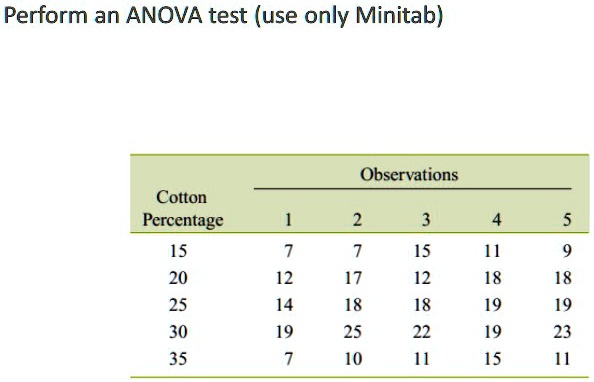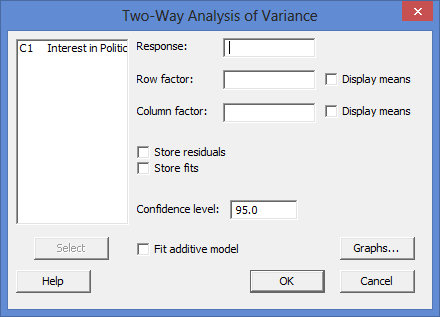
however, in this guide we focus on the analysis of variance table which reports the statistical significance of the one way anova, as shown below (for minitab 17). the minitab output for a one way anova includes many useful statistics, including descriptive statistics for the groups that you compared. Minitab output of the one way anova in minitab. Running a multifactor anova in minitab 17 (as the dialogue boxes and options have changed from v16). there we can highlight the factors listed on the left side (step 1 below) when we do that, the add button on the right will become available. With such values, it always an idea to check that they are not data entry errors! In this case, Line 27 in the Minitab Worksheet contains a result for Iridium with Ultrasonication and the result is rather lower than the other replicates, but at 2.54 SRs, not a cause for panic.Minitab 16's two way anova option also shows the two factor interaction, so in minitab 17 we need to manually add the interaction by clicking the model button in the glm dialog box. If any point varies by more than (about) three SRs, its a bad outlier. This is reported in terms of Standardised residuals (SRs). The last few lines report any unusual values. As there is no evidence of interaction (P = 0.898), we can interpret the results for the main factors in a fairly simple manner (See Chapter 14). There are significant differences among the catalysts and among the mixing methods (P reported as 0.000 in both cases). The key points are the P values in the last column of the section marked Analysis of Variance (Yellow background). Ultra + 0.140 Catalyst*Mix_Rh Stir - 0.140 Catalyst*Mix_Rh Ultraįits and Diagnostics for Unusual Observations + 0.060 Catalyst*Mix_Pd/Ir Ultra + 0.200 Catalyst*Mix_Pt Stir. Stir + 0.050 Catalyst*Mix_Pd Ultra - 0.060 Catalyst*Mix_Pd/Ir Stir 0.230 Catalyst*Mix_Ir Stir + 0.230 Catalyst*Mix_Ir Ultra. General Linear Model: Yield versus Catalyst, Mix The GLM box should then look like this:Ĭlick OK again and the output will be as on next page: This process adds the interaction term to the analysis. (See Section 14.3.6) In the Responses: box, enter Yield, and in Factors:, enter Catalyst and Mix.Ĭlick Model Under Factors and Covariates:, click Catalyst and then, holding down the key, click Mix, so they are both highlighted. Also, the GLM routine is tolerant of imbalanced data sets, so if for example, a lab accident led to the loss of one of the samples, we could still go ahead with a GLM analysis, but not with any of the traditional ANOVAs.

We choose GLM because its implementation in Minitab includes follow up tests like Tukeys, whereas the more obvious ANOVAs that are available from the menu, lack such facilities.
#Anova minitab mod
The worksheet should then look like this:įollow the menus: Stat / ANOVA / General Linear Mod / Fit General Linear Model Technically, the General Linear Model (GLM) routine uses a method of calculation that is different from the classical two way ANOVA, but the end result is exactly the same.

Enter all the percentage yields into the relevant column and put suitable labels into the other two columns.

Label one column to hold the yields (Yield) and two others for labels for the two factors (Catalyst and Mix).

Using Minitab to perform a two-way analysis of varianceĮxample: Table 14.7 Effects of catalyst and mixing method on yield (Percentage of theoretical maximum) Use the XL file Data for Table 14.7 (Minitab version) from the web site. These instructions are closely linked to the authors book:Įssential Statistics for the Pharmaceutical Sciences John Wiley & Sons Ltd For all references to chapters or tables, see the above book.


 0 kommentar(er)
0 kommentar(er)
